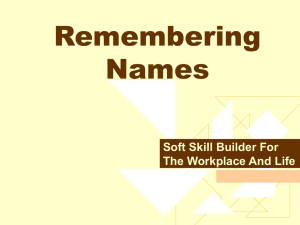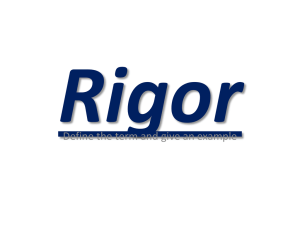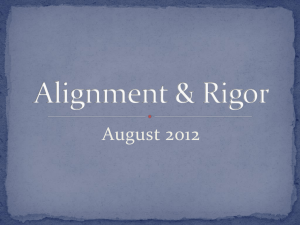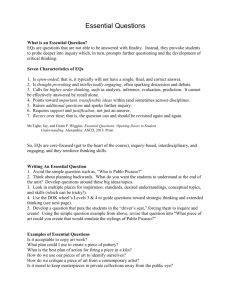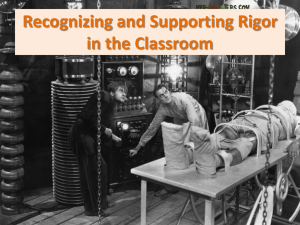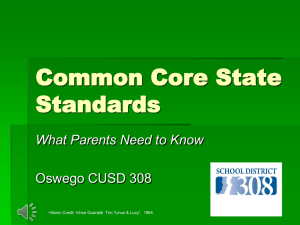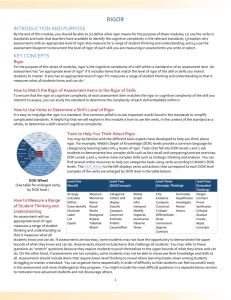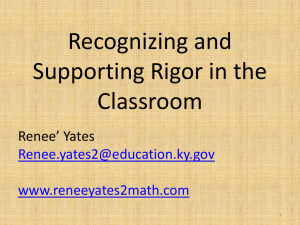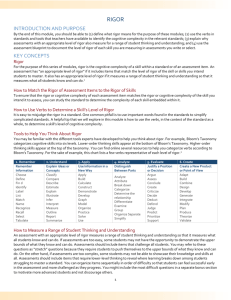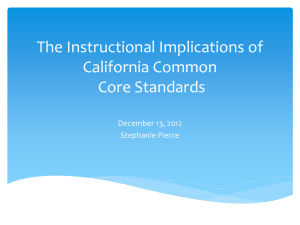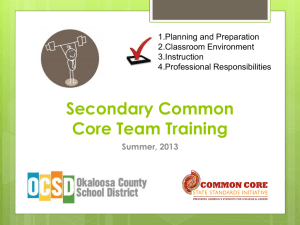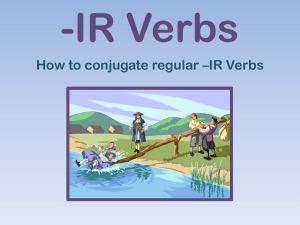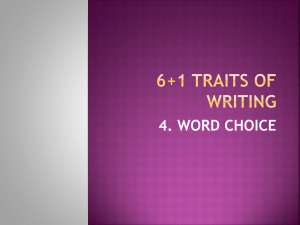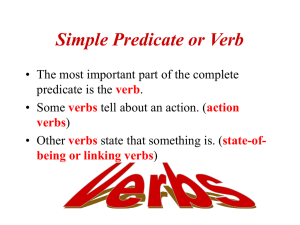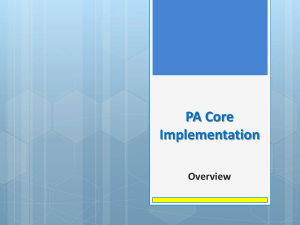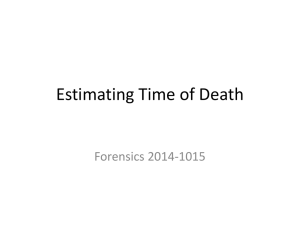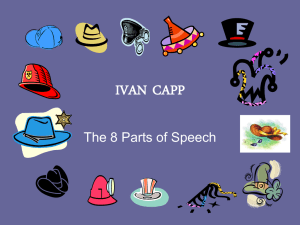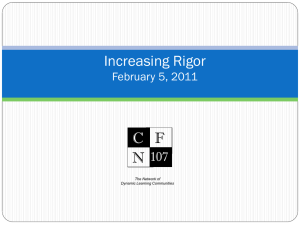Application - Poplar School
advertisement
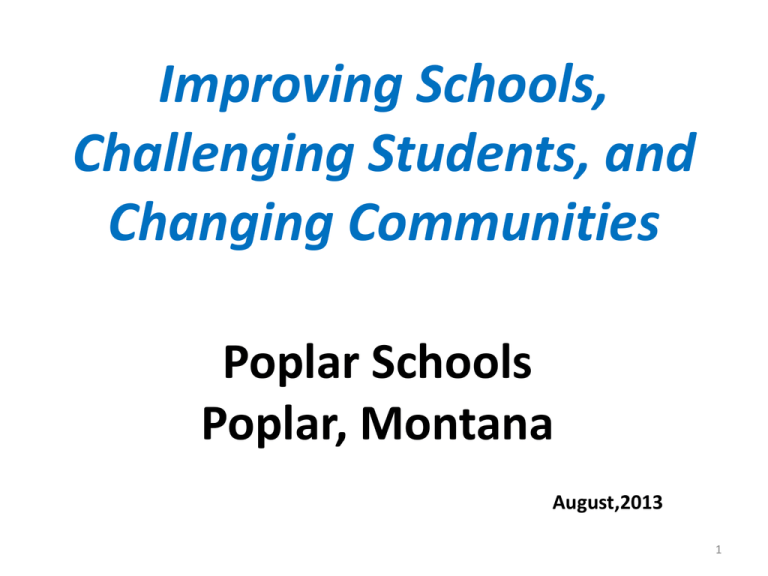
Improving Schools, Challenging Students, and Changing Communities Poplar Schools Poplar, Montana August,2013 1 Application Model 1. 2. 3. 4. Knowledge in one discipline Application within discipline Application across disciplines Application to real-world predictable situations 5. Application to real-world unpredictable situations •2 Knowledge Taxonomy 1. 2. 3. 4. 5. 6. Awareness Comprehension Application Analysis Synthesis Evaluation Levels Bloom’s 6 5 4 3 2 1 C D A B 1 2 3 Application 4 5 Rigor/Relevance Framework Bloom’s 6 5 4 3 2 1 College Ready Career Ready Test 1 2 CTE/ Jobs 3 Application 4 5 Quad D Skills and Knowledge • • • • • Decision Making Innovation/Creativity Goal Setting/Results Driven Multi Tasking Work with others •6 •7 Recommendations • • • • • Culture Trumps Strategy Literacy Across the Curriculum Rigor/Relevance Focused and Sustained System wide 8 Steps to Success 1. Develop Time and Content Grids. 2. Examine your data and develop a grid of results – know your student data. 3. Develop Alignment to Common Core Standards. 4. Student Expertise – relevance and rigor of student work. 5. Higher Order Thinking Skills 9 Content Knowledge PURPOSE STRUCTURE PATTERNS PROCESS 10 Purpose Language Arts: To communicate Social Studies: Identifying patterns of people and governments over time. Math: Assigning order and value to the universe. Chemistry: Bonding Algebra: Solving for the unknown. 11 Purpose • Geometry: Using logic to order and assign values to form and space. • Physics: Using matter and energy through math applications. • Earth science: Identifying and predicting physical phenomena. 12 Most Commonly used Prefixes [9] Prefix- a word part that can be added to the beginning of a root or base word that changes the meaning of a root or base word anti = against auto = self bi = two circum = around co, con, com = with contra = against de = opposite dis = reverse/opposite e, ex = out en, em = cause to in, im, il, ir = not inter = between macro = large micro = small mid = middle mis = wrongly mono = one non = not poly = many post = after pre = before re = back/again semi = partly sub = under super = above syn = same time trans = across tri = three un = not uni = one 1.1.A Supporting Standard © Educational Epiphany www.educationalepiphany.com 13 Most Commonly used Root Words [9] Root- a word part to which affixes (prefixes and suffixes) may be added to create related words audi = hear auto = self bene = good bio = life chrono = time cred = believe dict = say duc = lead fid = truth, faith flex = bend gen = give birth geo = earth graph = write greg = group jur, jus = law log = thought luc = light man = hand mand = order mis, mit = send omni = all path = feel phil = love phon = sound photo = light port = carry scrib = write sens, sent = feel spec, spect, spic = look tele = far off terr = earth vac = empty vid, vis = see 1.1.A Supporting Standard © Educational Epiphany www.educationalepiphany.com 410-258-6443 14 Most Commonly used Root Words [9] Root- a word part to which affixes (prefixes and suffixes) may be added to create related words audi = hear auto = self bene = good bio = life chrono = time cred = believe dict = say duc = lead fid = truth, faith flex = bend gen = give birth geo = earth graph = write greg = group jur, jus = law log = thought luc = light man = hand mand = order mis, mit = send omni = all path = feel phil = love phon = sound photo = light port = carry scrib = write sens, sent = feel spec, spect, spic = look tele = far off terr = earth vac = empty vid, vis = see 1.1.A Supporting Standard © Educational Epiphany www.educationalepiphany.com 410-258-6443 15 Cognitive Level I N C R E A S I N G C O M P L E X I T Y Starter Verbs match list write recite identify find group say tell name locate UNDERSTANDING explain change reword restate outline translate extend summarize reorganize APPLICATION apply try make use of solve employ use demonstrate construct using ANALYSIS analyze separate inspect identify parts sort examine classify discover reduce compare CREATING make develop compose create originate invent devise produce design EVALUATION evaluate award grade recommend decide rate assess choose rank judge put in order REMEMBERING Student Expected to … Learn specific facts, vocabulary, and ideas, and reiterate them in similar form. Communicate knowledge and interpret previous learning. Use learned knowledge, rules, ideas, and methods in new situations. Take apart or break down a thing or idea into its parts, and perceive the interrelationships. Use elements or ideas in new and original patterns and relationships. Make decisions or judgments based on chosen criteria or standards. 16 Thinking at Its Best Level of Thinking Preschool–Kindergarten Verbs Primary Verbs Intermediate Verbs REMEMBERING Remembering remembering, show, tell me, list, match, describe, name, repeat, locate match, describe, choose, remember, know tell, describe, name, recall, identify, recognize, memorize, reproduce, label UNDERSTANDING Understanding show, find, change, tell what it is about, describe, give examples explain, review, summarize, describe, change, give the main idea explain, summarize, interpret, restate, translate, give the main idea, give examples, convert APPLICATION Using what you know in a new situation use, dress up, solve, collect, act out, put in order, paint show, report, draw, collect, paint, give examples, put in order, use, act out solve, put in order, practice, demonstrate, prepare, report, act out, construct, relate examine, arrange, compare, categorize examine, categorize, test, separate, solve, chart, compare and show how things are alike/different compare/contrast, survey, classify, investigate, distinguish, calculate, research, diagram CREATING Putting it together in a new way improve, make up, imagine, pretend, suppose, create, invent create, invent, imagine, pretend, predict, construct, design, improve, compose imagine, create, predict, improve, pretend, invent, suppose, modify, change, hypothesize EVALUATION Judging the value of information decide, choose, tell why, prove judge, argue, select/choose, decide, prove, rate, measure, recommend, grade debate, solve, justify, recommend, appraise, validate, measure, estimate, evaluate ANALYSIS Taking it apart Developed by Falcon Elementary, Colorado 17 Questioning for Quality Thinking REMEMBERING Identification and recall of information Who, what, when, where, how____________________? Describe ______________________________________. UNDERSTANDING Organization and selection of facts and ideas Retell __________________________ in your own words. What is the main idea of __________________________? APPLICATION Use of facts, rules, principles How is _____________ an example of _____________? How is _____________ related to __________________? How does ________ compare/contrast with __________? Source: Division of Instruction, Maryland State Department of Education 18 Questioning for Quality Thinking ANALYSIS Separation of a whole into component parts What are the parts or features of ____________________? Classify _________ according to ___________________. How does ________ compare/contrast with __________? CREATING Combination of ideas to form a new whole What would you predict/infer from __________________? What ideas would you add to ______________________? How would you create/design a new ________________? What would happen if you combined ______ and ______? Source: Division of Instruction, Maryland State Department of Education 19 Questioning for Quality Thinking EVALUATION Development of opinions, judgments, or decisions Do you agree with _______________________________? What do you think about __________________________? What is the most important ________________________? Prioritize __________ according to _________________. How would you decide about ______________________? What criteria would you use to assess _______________? Source: Division of Instruction, Maryland State Department of Education 20 Source: Webb, Norman L. and others. “Web Alignment Tool” 24 July 2005. Wisconsin Center for Educational Research, University of Wisconsin. Cognitive Rigor Matrix This matrix from the Smarter Balanced Content Specifications for ELA draws from both Bloom’s (revised) Taxonomy of Educational Objectives and Webb’s Depth-of-Knowledge Levels below. Relationships Wisdom Hope Courage Respect Justice Responsibility Compassion Integrity 23 School Improvement • Career and Technical Preparation • Content • Rigor • Pedagogy • Relationships 24
